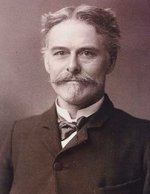Edward Drinker Cope
|
|
Edward Drinker Cope (July 28, 1840–April 12, 1897) was an American paleontologist and comparative anatomist.
Cope was born in Philadelphia to Quaker parents. At an early age he became interested in natural history, and in 1859 communicated a paper on the Salamandridae to the Academy of Natural Sciences at Philadelphia. He was educated partly in the University of Pennsylvania and, after further study and travel in Europe, was appointed curator to the Academy of Natural Sciences in 1865, a post which he held until 1873. From 1864–1867 he was professor of natural science at Haverford College, and in 1889 he was appointed professor of geology and paleontology by the University of Pennsylvania.
His speciality was the study of the American fossil vertebrata. From 1871–1877 he carried on explorations of the Cretaceous strata of Kansas, and the Tertiary in Wyoming and Colorado. He made known at least 1,000 new species in his lifetime, as well as many genera of extinct vertebrata. Among these were some of the oldest known mammals, obtained in New Mexico, and 56 species of dinosaur, including the Camarasaurus, and the Coelophysis. He was an incredibly prolific publisher, producing more than 1,200 scientific papers in his lifetime. He served on the U.S. Geological Survey in New Mexico (1874), Montana (1875), and in Oregon and Texas (1877). He was also one of the editors of the American Naturalist. He died in Philadelphia.
Cope's competition with Othniel Charles Marsh for the discovery of new fossils became known as the Bone Wars.
In 1994, maverick paleontologist Robert Bakker published an paper in the Journal of the Wyoming Geological Society, attempting define Cope's body as the holotype of Homo sapiens.
See also
- Cope's law
- An article (http://www.signonsandiego.com/news/features/20031015-9999_1c15type.html) on the quest to make Edward Drinker Cope the type specimen for Homo sapiens.fr:Edward Drinker Cope

